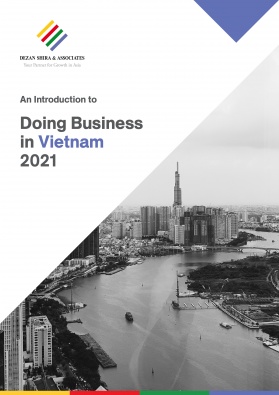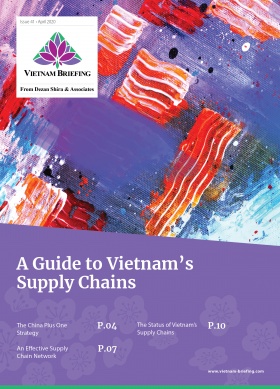Why Vietnam’s Public Investment Plan Matters for Investors
- In 2020, Vietnam recorded the highest disbursement rate for public investments. The country aims to distribute US$119 billion over the next four years.
- Public investments are a key component of Vietnam’s economic recovery particularly since private investment and consumption have lagged in 2020. GSO estimates that for every 1 percent increase in public investments, GDP rises by 0.06 percent.
- The focus of public investments has been Vietnam’s transport infrastructure and connectivity constraints. In the medium-term, foreign firms’ participation in public-private partnership projects particularly in connectivity infrastructure projects is likely to increase.
Vietnam’s Ministry of Planning and Investment (MPI) has estimated that in 2020 average disbursement rates for public investment exceeded 90 percent. This compares to 67 percent in 2019 and 66 percent in 2018. The 2020 target for public investment was set at US$27 billion.
Over the next four years, Vietnam has set a public investment budget of US$119 billion. This capital expenditure by federal and local government represents the ability and intention of the Vietnamese government to plan, coordinate and expedite public investment objectives.
In 2019 Vietnam introduced the Law on Public Investment, which is expected to accelerate decentralization, increase accountability and contribute to higher efficiency in public investment. In addition, public investment is a key component of the MPI’s Socioeconomic Development Plan 2021-2025.
Public investment is a key component of the post-pandemic recovery and is expected to be targeted at infrastructure assets that increase intra-regional connectivity. Going forward, it is also expected that foreign capital’s participation in these projects is likely to increase and opportunities for public-private partnerships could attract foreign firms into sectors such as transport and infrastructure.
Vietnam Briefing discusses three reasons why public investment plans in Vietnam impact foreign investors in the country.
1. Contribution to GDP: Positive spill-overs
Amid the pandemic, a slowdown was witnessed in key drivers of economic growth such as consumption and private investment. Despite these effects, the country recorded a 2.9 percent growth rate in 2020. This economic expansion was a result of not only higher public investment but also greater efficiency in the distribution of funds.
Increases in public investment are associated with positive spill-overs such as increases in aggregate demand, investor confidence, and local economic activity in regions where the investment is targeted. For example, public investment resulted in 6.7 percent growth in the Vietnamese construction industry in 2020. In turn, this increased demand for materials, technology, and labor.
Therefore, these spill-overs contribute to the economy at large. The General Statistics Office (GSO) estimates that for every 1 percent increase in public spending, GDP rises by 0.06 percent.
The public investment agenda has consequently played a key role in Vietnam’s economic recovery in 2020 and it is likely that over the next four years, similar spill-over effects are observed in sectors such as construction, transport, utilities, and materials.
2. The connectivity agenda
A significant portion of these public investments are targeted at key connectivity projects. These include the national coastal network, My Thuan bridge, Cat Linh – Ha Dong urban railway, and the eastern cluster of the North-South Expressway among others.
The North-South Expressway project covers 654 km, 13 civil work packages, and has an estimated value of US$5 billion. Included in the 2021-2025 public investment plan are three key projects of this expressway: the Mai Son-National Highway No.45, Vinh Hao-Phan Thiet, and Phan Thiet-Dau Giay. The government expects these three projects to significantly alleviate congestion pressure, meet mobility demand and reduce transport cost, and time for companies operating in the country. Likewise, the national coastal road has been a key component of the government’s attempt to invest in connectivity and transport infrastructure.
This focus on connectivity and transport infrastructure is a welcome move for foreign investors who seek to maximize their efficiency gains from Vietnam. In recent years, many of the nation’s highways, airports, and ports have experienced congestion and rising demand pressure.
3. Opportunities for foreign firms and public-private partnerships.
In addition to increasing volume and efficiency in public investment, Vietnam also plans to increase private and foreign capital’s participation in these projects.
The main channel for this is public-private partnerships under the Ministry of Transport and sub-entities such as Directorate for Roads of Vietnam, the Vietnam Railway Authority, and the Civil Aviation Authority of Vietnam.
Recently, Vietnam introduced a new law governing public-private partnerships. The law includes a focus on five sectors: transportation, healthcare, education, transmission grid, and water. PPP projects in these sectors will also be extended preferred corporate income tax, preferential land use fee structures, and credit support.
The law also indicates that to qualify as a PPP project, a minimum investment capital commitment of US$ 8.5 million is needed, with the state restricted to 50 percent of the project value. In order to increase the attractiveness of the PPP model for foreign firms, the government has also signaled a willingness to offer guarantees of access to and patterns of land use.
It is expected that the new PPP law could result in average annual construction growth of 6.8 percent between 2021 and 2029. This could increase market opportunities in consulting, design, construction, project management, and high-value industrial goods. Currently, companies from South Korea, Japan, and China are active participants in the transport infrastructure market and it is likely that a broader range of foreign firms participate in these projects in the medium-term.
About Us
Vietnam Briefing is produced by Dezan Shira & Associates. The firm assists foreign investors throughout Asia from offices across the world, including in Hanoi and Ho Chi Minh City. Readers may write to vietnam@dezshira.com for more support on doing business in Vietnam.
- Previous Article Handel zwischen Vietnam und Deutschland: Wie man das EVFTA nutzen kann
- Next Article Vietnam’s Economic Growth On Track as National Party Congress Concludes







